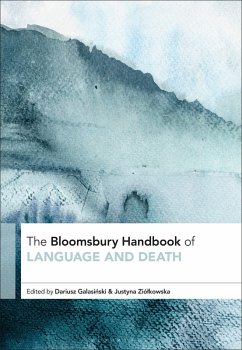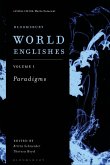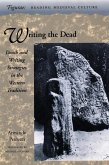The Bloomsbury Handbook of Language and Death
Herausgeber: Galasinski, Dariusz; Ziólkowska, Justyna
Versandkostenfrei innerhalb Deutschlands
172,99 €
inkl. MwSt.
Versandkostenfrei*
Erscheint vorauss. 5. März 2026
Melden Sie sich
hier
hier
für den Produktalarm an, um über die Verfügbarkeit des Produkts informiert zu werden.

86 °P sammeln
The Bloomsbury Handbook of Language and Death
Herausgeber: Galasinski, Dariusz; Ziólkowska, Justyna
- Gebundenes Buch
An essential reference to the intersection of language and death and dying, this book presents an overview of the methodologies, current debates, history and future of research in language-related death studies. Adopting a highly interdisciplinary approach, the book explores a wide variety of phenomena and contexts of death and dying, examining language and discourse from linguistic, psychological, philosophical, and anthropological perspectives, among others. Divided into three parts, it considers three viewpoints from which death and dying can be understood: first-person, second-person, and…mehr
Andere Kunden interessierten sich auch für
![The Bloomsbury Handbook of Saussure The Bloomsbury Handbook of Saussure]() The Bloomsbury Handbook of Saussure171,99 €
The Bloomsbury Handbook of Saussure171,99 €![Bloomsbury World Englishes Volume 1: Paradigms Bloomsbury World Englishes Volume 1: Paradigms]() Bloomsbury World Englishes Volume 1: Paradigms214,99 €
Bloomsbury World Englishes Volume 1: Paradigms214,99 €![Bloomsbury World Englishes Volume 3: Pedagogies Bloomsbury World Englishes Volume 3: Pedagogies]() Bloomsbury World Englishes Volume 3: Pedagogies214,99 €
Bloomsbury World Englishes Volume 3: Pedagogies214,99 €![Writing the Dead Writing the Dead]() Armando PetrucciWriting the Dead65,99 €
Armando PetrucciWriting the Dead65,99 €![The Bloomsbury Companion to Discourse Analysis The Bloomsbury Companion to Discourse Analysis]() The Bloomsbury Companion to Discourse Analysis52,99 €
The Bloomsbury Companion to Discourse Analysis52,99 €![The Oxford Handbook of Ritual Language The Oxford Handbook of Ritual Language]() The Oxford Handbook of Ritual Language181,99 €
The Oxford Handbook of Ritual Language181,99 €![The Handbook of Language Variation and Change The Handbook of Language Variation and Change]() JK ChambersThe Handbook of Language Variation and Change61,99 €
JK ChambersThe Handbook of Language Variation and Change61,99 €-
-
-
An essential reference to the intersection of language and death and dying, this book presents an overview of the methodologies, current debates, history and future of research in language-related death studies. Adopting a highly interdisciplinary approach, the book explores a wide variety of phenomena and contexts of death and dying, examining language and discourse from linguistic, psychological, philosophical, and anthropological perspectives, among others. Divided into three parts, it considers three viewpoints from which death and dying can be understood: first-person, second-person, and third-person. The chapters cover an extensive array of topics, from presentations of death within social media and news reports, through to specific contexts of dying and types of death, including palliative care, assisted dying, suicide, and COVID-19. They also engage with data from across a range of national, cultural, and linguistic contexts, offering a broad international perspective.
Produktdetails
- Produktdetails
- Verlag: Bloomsbury Academic
- Seitenzahl: 416
- Erscheinungstermin: 5. März 2026
- Englisch
- Abmessung: 244mm x 169mm x 25mm
- Gewicht: 454g
- ISBN-13: 9781350302013
- ISBN-10: 1350302015
- Artikelnr.: 75808716
- Herstellerkennzeichnung
- Libri GmbH
- Europaallee 1
- 36244 Bad Hersfeld
- gpsr@libri.de
- Verlag: Bloomsbury Academic
- Seitenzahl: 416
- Erscheinungstermin: 5. März 2026
- Englisch
- Abmessung: 244mm x 169mm x 25mm
- Gewicht: 454g
- ISBN-13: 9781350302013
- ISBN-10: 1350302015
- Artikelnr.: 75808716
- Herstellerkennzeichnung
- Libri GmbH
- Europaallee 1
- 36244 Bad Hersfeld
- gpsr@libri.de
Dariusz Galasinski is Visiting Professor at Adam Mickiewicz University, Poland. Justyna Ziólkowska is Associate Professor of Clinical Psychology in the University of Social Sciences and Humanities, Poland.
List of Figures List of Tables Introduction
Justyna Ziólkowska (SWPS University
Poland)
Dariusz Galasinski (University of Wroclaw
Poland) and Magdalena Witkowicz (University of Wroclaw
Poland) Part I: Personal Experiences of Death 1. The Good Death
Alex Broom
Nadine Ehlers
Henrietta Byrne
Leah Williams Veazey and Katherine Kenny (University of Sydney
Australia) 2. The Identification of Linguistic Markers of Suicidal Ideation on Social Media: Computational and Corpus Approaches
Andrea Vaughan (University College London
UK) 3. "There Are no Words": Designating Infant Loss through the Lens of Situated Discourse Analysis
Giuditta Caliendo and Catherine Ruchon (University of Lille
France) 4. The Sociolinguistics of Dying
Death and Mourning: Remediating Practices of Language
Narrative
and Affect in Digital Contexts
Korina Giaxoglou (Open University
UK) 5. Medicalisation of Death in COVID-19 Memorials
Dariusz Galasinski (University of Wroclaw
Poland)
Magdalena Witkowicz (University of Wroclaw
Poland) and Justyna Ziólkowska (University of Social Sciences and Humanities
Poland) 6. Corpse Poetry
Dead Bodies and Linguistic Survival
Katrina Jaworski ( Adelaide University
Australia) and Daniel G. Scott (University of Victoria
Canada) Part II: Death from a Professional Perspective 7. Communicating Death in Intensive Care: The Impact of Prior Family Interactions on Breaking the News
Ana Cristina Ostermann (Universidade Federal do Rio Grande do Sul (UFRGS)
Brazil)
Paola Gabriela Konrad (Universidade do Vale do Rio dos Sinos (Unisinos)
Brazil) and José Roberto Goldim (Hospital de Clínicas de Porto Alegre (HCPA)
Brazil) 8. Psychiatrists
Suicide and Clinical Communication
Rob Poole (Bangor University
UK) 9. Medicalised or Criminalised? Gendered Constructions of Killers Within Legal and Psychiatric Narratives
Agnieszka Karlinska (NASK National Research Institute
Poland) 10. Telling of Killing: The Discursive Construction of Morality in Accounts of Taking Life
Robin Conley Riner (Marshall University
USA) 11. Discursive Perspectives on Assisted Dying
Gavin Brookes (Lancaster University
UK) and David Wright (University of Southampton
UK) 12. Assisted Dying: Mapping the Terrain
Jessica Young (University of Otago
New Zealand)
Bryanna Moore (University of Texas Medical Branch
USA) and Courtney Hempton (Deakin University
Australia) 13. The Language of Suicide
David Lester (Stockton University
USA) Part III: Public Representations of Death 14. Death and the Sacred in the Digital Age
Adela Toplean (University of Bucharest
Romania) 15. Talking about Death to Young Children: The Metaphorical Representation of Death in Children's Literature
Sara Vilar-Lluch (King's College London
UK) 16. Death in the News: A Corpus-Based Critical Discourse Analysis
Rakan Alibri (Lancaster University
UK) 17. Dementia
Death and Discourse
Emma Putland and Gavin Brookes (Lancaster University
UK) 18. Intersecting Discourses of Death and the Climate Crisis
Niall Curry (Manchester Metropolitan University
UK) 19. Freezing Death: Cryopreservation as a Challenge to the Inevitability of Death
Kim Grego (University of Milan
Italy) Index
Justyna Ziólkowska (SWPS University
Poland)
Dariusz Galasinski (University of Wroclaw
Poland) and Magdalena Witkowicz (University of Wroclaw
Poland) Part I: Personal Experiences of Death 1. The Good Death
Alex Broom
Nadine Ehlers
Henrietta Byrne
Leah Williams Veazey and Katherine Kenny (University of Sydney
Australia) 2. The Identification of Linguistic Markers of Suicidal Ideation on Social Media: Computational and Corpus Approaches
Andrea Vaughan (University College London
UK) 3. "There Are no Words": Designating Infant Loss through the Lens of Situated Discourse Analysis
Giuditta Caliendo and Catherine Ruchon (University of Lille
France) 4. The Sociolinguistics of Dying
Death and Mourning: Remediating Practices of Language
Narrative
and Affect in Digital Contexts
Korina Giaxoglou (Open University
UK) 5. Medicalisation of Death in COVID-19 Memorials
Dariusz Galasinski (University of Wroclaw
Poland)
Magdalena Witkowicz (University of Wroclaw
Poland) and Justyna Ziólkowska (University of Social Sciences and Humanities
Poland) 6. Corpse Poetry
Dead Bodies and Linguistic Survival
Katrina Jaworski ( Adelaide University
Australia) and Daniel G. Scott (University of Victoria
Canada) Part II: Death from a Professional Perspective 7. Communicating Death in Intensive Care: The Impact of Prior Family Interactions on Breaking the News
Ana Cristina Ostermann (Universidade Federal do Rio Grande do Sul (UFRGS)
Brazil)
Paola Gabriela Konrad (Universidade do Vale do Rio dos Sinos (Unisinos)
Brazil) and José Roberto Goldim (Hospital de Clínicas de Porto Alegre (HCPA)
Brazil) 8. Psychiatrists
Suicide and Clinical Communication
Rob Poole (Bangor University
UK) 9. Medicalised or Criminalised? Gendered Constructions of Killers Within Legal and Psychiatric Narratives
Agnieszka Karlinska (NASK National Research Institute
Poland) 10. Telling of Killing: The Discursive Construction of Morality in Accounts of Taking Life
Robin Conley Riner (Marshall University
USA) 11. Discursive Perspectives on Assisted Dying
Gavin Brookes (Lancaster University
UK) and David Wright (University of Southampton
UK) 12. Assisted Dying: Mapping the Terrain
Jessica Young (University of Otago
New Zealand)
Bryanna Moore (University of Texas Medical Branch
USA) and Courtney Hempton (Deakin University
Australia) 13. The Language of Suicide
David Lester (Stockton University
USA) Part III: Public Representations of Death 14. Death and the Sacred in the Digital Age
Adela Toplean (University of Bucharest
Romania) 15. Talking about Death to Young Children: The Metaphorical Representation of Death in Children's Literature
Sara Vilar-Lluch (King's College London
UK) 16. Death in the News: A Corpus-Based Critical Discourse Analysis
Rakan Alibri (Lancaster University
UK) 17. Dementia
Death and Discourse
Emma Putland and Gavin Brookes (Lancaster University
UK) 18. Intersecting Discourses of Death and the Climate Crisis
Niall Curry (Manchester Metropolitan University
UK) 19. Freezing Death: Cryopreservation as a Challenge to the Inevitability of Death
Kim Grego (University of Milan
Italy) Index
List of Figures List of Tables Introduction
Justyna Ziólkowska (SWPS University
Poland)
Dariusz Galasinski (University of Wroclaw
Poland) and Magdalena Witkowicz (University of Wroclaw
Poland) Part I: Personal Experiences of Death 1. The Good Death
Alex Broom
Nadine Ehlers
Henrietta Byrne
Leah Williams Veazey and Katherine Kenny (University of Sydney
Australia) 2. The Identification of Linguistic Markers of Suicidal Ideation on Social Media: Computational and Corpus Approaches
Andrea Vaughan (University College London
UK) 3. "There Are no Words": Designating Infant Loss through the Lens of Situated Discourse Analysis
Giuditta Caliendo and Catherine Ruchon (University of Lille
France) 4. The Sociolinguistics of Dying
Death and Mourning: Remediating Practices of Language
Narrative
and Affect in Digital Contexts
Korina Giaxoglou (Open University
UK) 5. Medicalisation of Death in COVID-19 Memorials
Dariusz Galasinski (University of Wroclaw
Poland)
Magdalena Witkowicz (University of Wroclaw
Poland) and Justyna Ziólkowska (University of Social Sciences and Humanities
Poland) 6. Corpse Poetry
Dead Bodies and Linguistic Survival
Katrina Jaworski ( Adelaide University
Australia) and Daniel G. Scott (University of Victoria
Canada) Part II: Death from a Professional Perspective 7. Communicating Death in Intensive Care: The Impact of Prior Family Interactions on Breaking the News
Ana Cristina Ostermann (Universidade Federal do Rio Grande do Sul (UFRGS)
Brazil)
Paola Gabriela Konrad (Universidade do Vale do Rio dos Sinos (Unisinos)
Brazil) and José Roberto Goldim (Hospital de Clínicas de Porto Alegre (HCPA)
Brazil) 8. Psychiatrists
Suicide and Clinical Communication
Rob Poole (Bangor University
UK) 9. Medicalised or Criminalised? Gendered Constructions of Killers Within Legal and Psychiatric Narratives
Agnieszka Karlinska (NASK National Research Institute
Poland) 10. Telling of Killing: The Discursive Construction of Morality in Accounts of Taking Life
Robin Conley Riner (Marshall University
USA) 11. Discursive Perspectives on Assisted Dying
Gavin Brookes (Lancaster University
UK) and David Wright (University of Southampton
UK) 12. Assisted Dying: Mapping the Terrain
Jessica Young (University of Otago
New Zealand)
Bryanna Moore (University of Texas Medical Branch
USA) and Courtney Hempton (Deakin University
Australia) 13. The Language of Suicide
David Lester (Stockton University
USA) Part III: Public Representations of Death 14. Death and the Sacred in the Digital Age
Adela Toplean (University of Bucharest
Romania) 15. Talking about Death to Young Children: The Metaphorical Representation of Death in Children's Literature
Sara Vilar-Lluch (King's College London
UK) 16. Death in the News: A Corpus-Based Critical Discourse Analysis
Rakan Alibri (Lancaster University
UK) 17. Dementia
Death and Discourse
Emma Putland and Gavin Brookes (Lancaster University
UK) 18. Intersecting Discourses of Death and the Climate Crisis
Niall Curry (Manchester Metropolitan University
UK) 19. Freezing Death: Cryopreservation as a Challenge to the Inevitability of Death
Kim Grego (University of Milan
Italy) Index
Justyna Ziólkowska (SWPS University
Poland)
Dariusz Galasinski (University of Wroclaw
Poland) and Magdalena Witkowicz (University of Wroclaw
Poland) Part I: Personal Experiences of Death 1. The Good Death
Alex Broom
Nadine Ehlers
Henrietta Byrne
Leah Williams Veazey and Katherine Kenny (University of Sydney
Australia) 2. The Identification of Linguistic Markers of Suicidal Ideation on Social Media: Computational and Corpus Approaches
Andrea Vaughan (University College London
UK) 3. "There Are no Words": Designating Infant Loss through the Lens of Situated Discourse Analysis
Giuditta Caliendo and Catherine Ruchon (University of Lille
France) 4. The Sociolinguistics of Dying
Death and Mourning: Remediating Practices of Language
Narrative
and Affect in Digital Contexts
Korina Giaxoglou (Open University
UK) 5. Medicalisation of Death in COVID-19 Memorials
Dariusz Galasinski (University of Wroclaw
Poland)
Magdalena Witkowicz (University of Wroclaw
Poland) and Justyna Ziólkowska (University of Social Sciences and Humanities
Poland) 6. Corpse Poetry
Dead Bodies and Linguistic Survival
Katrina Jaworski ( Adelaide University
Australia) and Daniel G. Scott (University of Victoria
Canada) Part II: Death from a Professional Perspective 7. Communicating Death in Intensive Care: The Impact of Prior Family Interactions on Breaking the News
Ana Cristina Ostermann (Universidade Federal do Rio Grande do Sul (UFRGS)
Brazil)
Paola Gabriela Konrad (Universidade do Vale do Rio dos Sinos (Unisinos)
Brazil) and José Roberto Goldim (Hospital de Clínicas de Porto Alegre (HCPA)
Brazil) 8. Psychiatrists
Suicide and Clinical Communication
Rob Poole (Bangor University
UK) 9. Medicalised or Criminalised? Gendered Constructions of Killers Within Legal and Psychiatric Narratives
Agnieszka Karlinska (NASK National Research Institute
Poland) 10. Telling of Killing: The Discursive Construction of Morality in Accounts of Taking Life
Robin Conley Riner (Marshall University
USA) 11. Discursive Perspectives on Assisted Dying
Gavin Brookes (Lancaster University
UK) and David Wright (University of Southampton
UK) 12. Assisted Dying: Mapping the Terrain
Jessica Young (University of Otago
New Zealand)
Bryanna Moore (University of Texas Medical Branch
USA) and Courtney Hempton (Deakin University
Australia) 13. The Language of Suicide
David Lester (Stockton University
USA) Part III: Public Representations of Death 14. Death and the Sacred in the Digital Age
Adela Toplean (University of Bucharest
Romania) 15. Talking about Death to Young Children: The Metaphorical Representation of Death in Children's Literature
Sara Vilar-Lluch (King's College London
UK) 16. Death in the News: A Corpus-Based Critical Discourse Analysis
Rakan Alibri (Lancaster University
UK) 17. Dementia
Death and Discourse
Emma Putland and Gavin Brookes (Lancaster University
UK) 18. Intersecting Discourses of Death and the Climate Crisis
Niall Curry (Manchester Metropolitan University
UK) 19. Freezing Death: Cryopreservation as a Challenge to the Inevitability of Death
Kim Grego (University of Milan
Italy) Index







